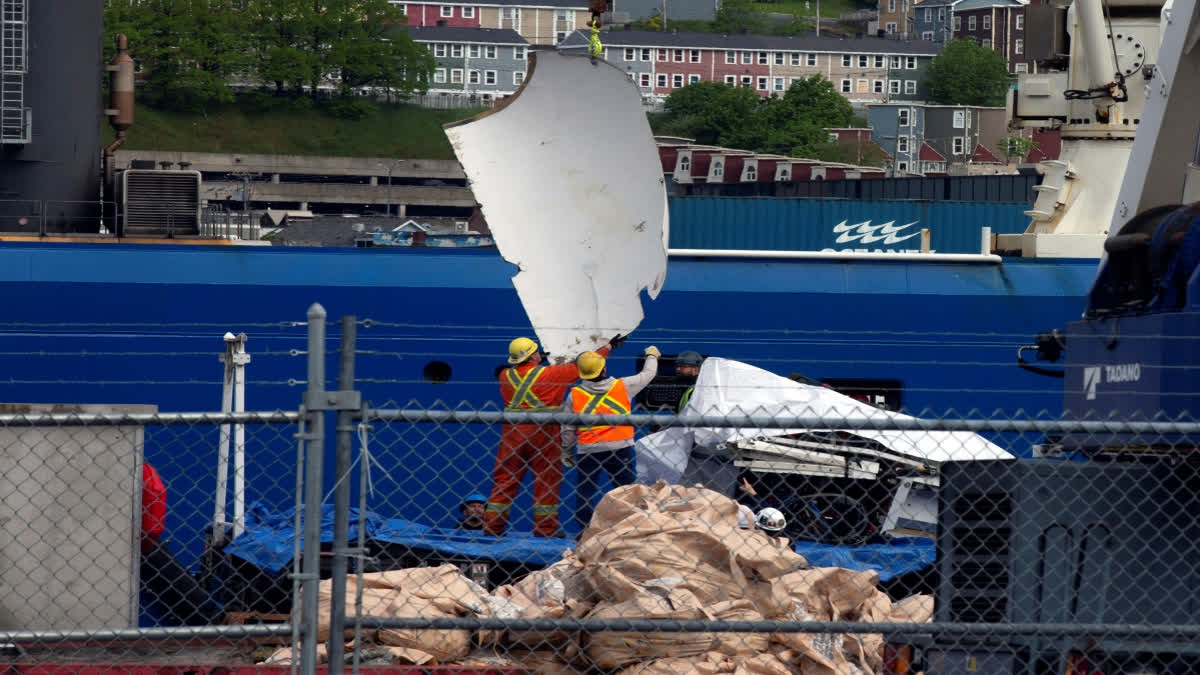Portland (Maine): Human remains have likely been recovered from the wreckage of the submersible that imploded on a voyage to view the wreckage of the Titanic, the U.S. Coast Guard said Wednesday.
The announcement came hours after the announcement that debris from the Titan, collected from the seafloor more than 12,000 feet (3,658 meters) below the surface of the North Atlantic, had arrived in St. John's, Newfoundland. Twisted chunks of the submersible were unloaded at a Canadian Coast Guard pier.
Recovering and scrutinizing the wreckage is a key part of the investigation into why the Titan imploded last week, killing all five people on board. The multiday search and eventual recovery of debris from the 22-foot (6.7-meter) vessel captured the world's attention.
"There is still a substantial amount of work to be done to understand the factors that led to the catastrophic loss of the Titan and help ensure a similar tragedy does not occur again," Coast Guard Chief Capt. Jason Neubauer said in a statement released late Wednesday afternoon.
The "presumed remains" will be brought to the United States, where medical professionals will conduct a formal analysis, and the Coast Guard has convened an investigation of the implosion at the highest level, Neubauer said, noting that the Marine Board of Investigation will analyze and test evidence, including pieces of debris, at a port in the U.S. He said the evidence will provide "critical insights" into the cause of the implosion.
Debris from the Titan, which is believed to have imploded on June 18 as it made its descent, was located about 12,500 feet (3,810 meters) underwater and roughly 1,600 feet (488 meters) from the Titanic on the ocean floor. The Coast Guard is leading the investigation, in conjunction with several other government agencies in the U.S. and Canada.
Authorities have not disclosed details of the debris recovery, which could have followed several approaches, according to Carl Hartsfield, who directs a lab at the Woods Hole Oceanographic Institution that designs and operates autonomous underwater vehicles and has been serving as a consultant to the Coast Guard.
"If the pieces are small, you can collect them together and put them in a basket or some kind of collection device," Hartsfield said Monday. Bigger pieces could be retrieved with a remote-operated vehicle, or ROV, such as the one brought to the wreckage site by the Canadian ship Horizon Arctic to search the ocean floor. For extremely big pieces a heavy lift can be used to pull the pieces up with a tow line, he said. Representatives for Horizon Arctic did not respond to requests for comment.
Pelagic Research Services, a company with offices in Massachusetts and New York that owns the ROV, said on Wednesday that it is "still on mission" and cannot comment on the investigation, said company spokesperson Jeff Mahoney.
Also read: Disaster, opulence, and the merciless ocean: why the Titanic disaster continues to enthral
"They have been working around the clock now for 10 days, through the physical and mental challenges of this operation," Mahoney said. Analyzing the physical material of recovered debris could reveal important clues about what happened to the Titan, and there could be electronic data recorded by the submersible's instruments, Hartsfield said.
"So the question is, is there any data available? And I really don't know the answer to that question," he said Monday. OceanGate CEO and pilot Stockton Rush was killed in the implosion along with two members of a prominent Pakistani family, Shahzada Dawood and his son Suleman Dawood; British adventurer Hamish Harding; and Titanic expert Paul-Henri Nargeolet.
Also read: US Navy: Hefty salvage system not required in probe of fatal Titan implosion
OceanGate Expeditions, the company that owned and operated the Titan, is based in the U.S. but the submersible was registered in the Bahamas. The OceanGate company in Everett, Washington, closed when the Titan was found. The Titan's mother ship, the Polar Prince, is based in Canada.
The operator charged passengers $250,000 each to participate in the voyage. The implosion of the Titan has raised questions about the safety of private undersea exploration operations. The Coast Guard also wants to use the investigation to improve safety of submersibles. (AP)
Also read: With the fate of those on Titanic-bound submersible known, focus turns to cause of fatal implosion



